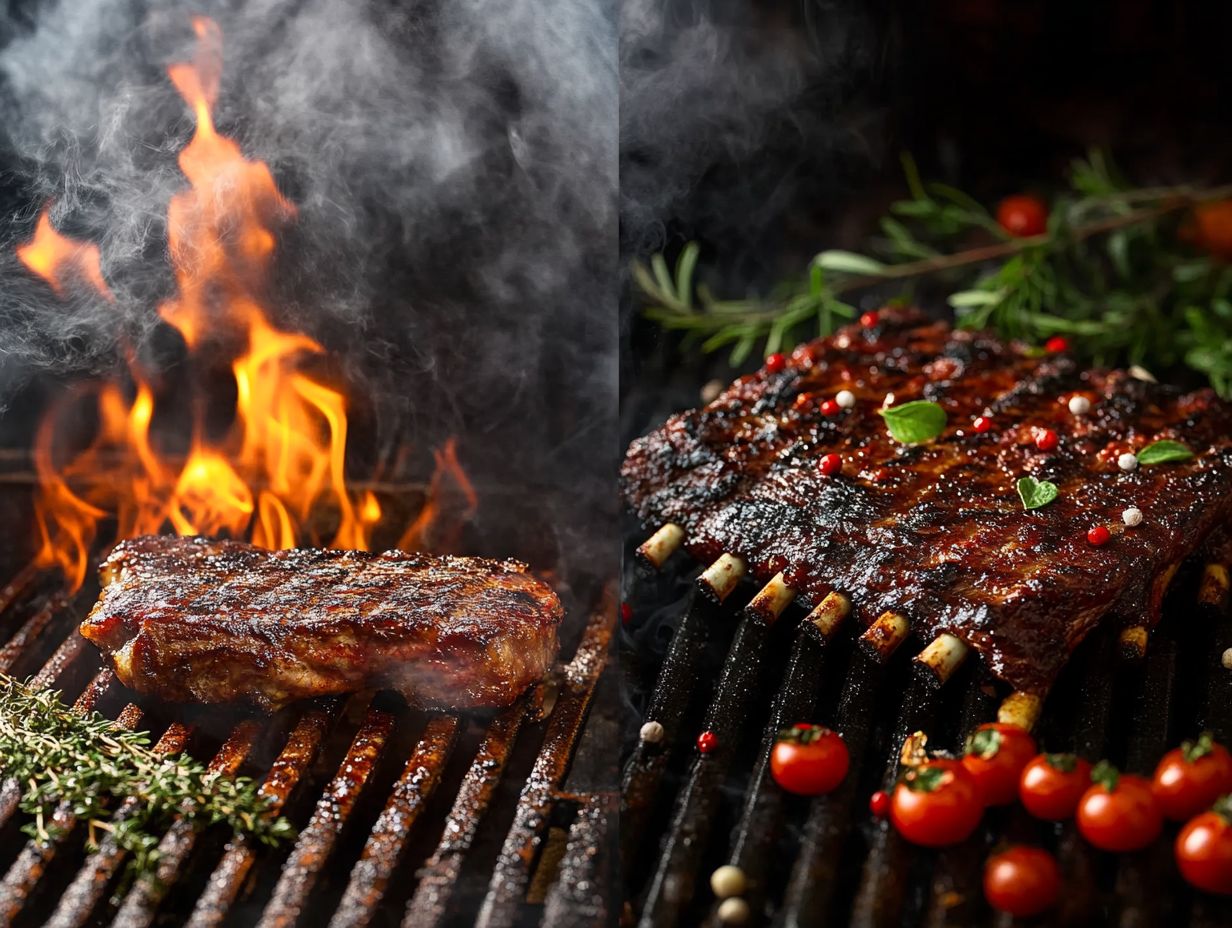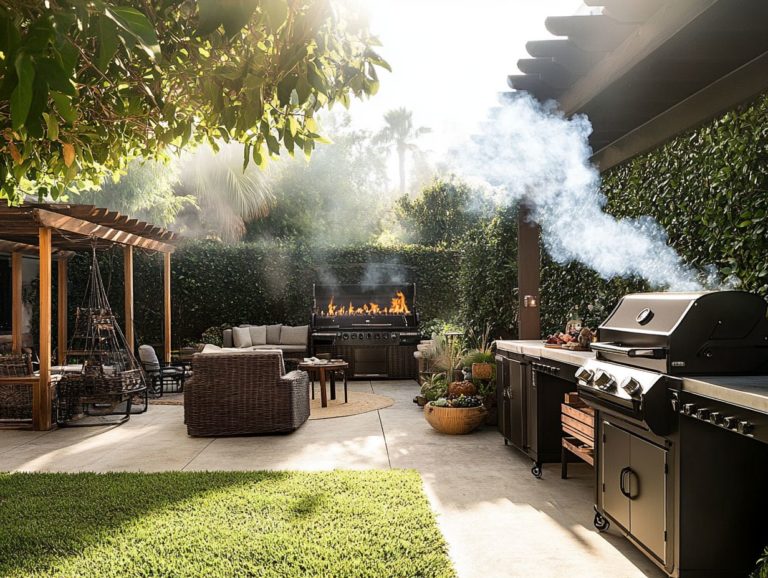What’s the Difference Between Grilling and Smoking?
Grilling and smoking are two revered cooking techniques that elevate ordinary ingredients into extraordinary meals. Each method introduces its own distinctive flavors and textures, making them beloved by food enthusiasts everywhere. Incorporating various cooking methods like barbecuing can enhance your culinary adventures.
Grilling allows for quick, high-heat cooking. It’s perfect for busy weeknight dinners.
Smoking requires patience. It infuses rich, smoky flavors into your meats over time, especially with wood chips like hickory or mesquite. This article delves into the definitions and fundamental techniques of both methods, highlighting their key differences and offering valuable tips for achieving mouthwatering results, including the best practices for using a charcoal grill or gas grill.
It also covers important health considerations that you should keep in mind regarding food safety and the impact of cooking techniques on your nutrition. Whether you re just starting out or are a seasoned pro in the kitchen, get ready to uncover tips that will transform you into a grilling and smoking superstar!
Contents
Key Takeaways:
- Grilling and smoking offer unique methods with distinct techniques and equipment.
- The main differences between grilling and smoking lie in how food is cooked and the resulting flavors and textures.
- Understanding when to grill or smoke can lead to better results with different foods.

Overview of Grilling and Smoking
Grilling and smoking are two exquisite outdoor cooking methods that elevate meat into tender, juicy masterpieces, making them critical for summer barbecues and backyard cooking.
While grilling harnesses the power of direct heat from a charcoal or gas grill, smoking embraces cooking at a low temperature for a long time that infuses flavors through aromatic wood chips, enhancing flavor and moisture retention of the meat.
Both methods showcase the versatility of outdoor cooking and cater to an array of preferences, positioning them as essential skills for any culinary enthusiast.
Grilling vs. Smoking: Key Differences
Grasping the essential distinctions between grilling and smoking is vital for anyone aspiring to master these flavorful cooking techniques. Each method presents its own unique advantages, tailored to satisfy a range of culinary cravings, whether you re grilling hamburgers or smoking brisket.
Cooking Method and Equipment
The method and equipment you choose for outdoor cooking, such as a Traeger Ironwood 885 or Big Green Egg, play a pivotal role in shaping your culinary adventure.
As you explore the various equipment options, you’ll notice that each brings its own distinct advantages. Charcoal grills impart an authentic smoky flavor that many outdoor chefs cherish, while gas grills offer the convenience of quick heat and precise temperature control.
On the other hand, smokers come in an array of types electric, offset, and pellet smokers each allowing for diverse cooking styles and flavor profiles.
Don’t overlook the importance of propane tanks for your gas grills; their size can significantly affect cooking efficiency and the length of your grilling sessions. This ensures you can enjoy seamless meal preparation and serving, allowing you to focus on what truly matters delighting in the flavors and moments created around the grill.
Fire up your grill or smoker today and start creating unforgettable meals!
Flavor and Texture

The flavor and texture of grilled and smoked meats are profoundly influenced by the cooking techniques you choose. Each method yields distinct outcomes that elevate your dining experience.
When you grill, you’re searing proteins at high temperatures. This gives you an amazing sear that locks in juiciness for a satisfying bite. On the other hand, smoking gently infuses the meat with complex, rich flavors over an extended period, allowing it to retain moisture and remain tender.
A key element of smoking is the formation of smoke rings, those alluring visual cues that show the depth of flavor achieved during the process. The choice of wood chips is also crucial. Hickory offers a robust, bacon-like taste, while mesquite brings a bold sweetness to the table. Each wood type contributes to a truly unique flavor profile, transforming any meal into a memorable delight.
When to Use Grilling vs. Smoking
Choosing between grilling and smoking hinges on your specific meal preparation goals and the type of gathering you re hosting. Each method shines in its own right, crafting delicious dishes that satisfy a variety of palates.
Do you love the quick, high-heat approach of grilling? Or perhaps the slow, rich flavors of smoking? Both methods can elevate your cooking experience!
Best Uses for Each Cooking Method
Understanding the best uses for each cooking method can truly elevate your cooking skills. This enables you to select the right technique tailored to specific cuts of meat and the flavors you wish to achieve.
Take grilling, for example. Cuts like hamburgers, ribeye steaks, and chicken breasts shine when subjected to high heat. This technique gives you an amazing sear that locks in juiciness while developing that irresistible charred flavor.
For tougher cuts like ribs and brisket, smoking is the best method. This slow cooking breaks down tough proteins, making the meat tender and delicious. Mastering the right temperatures is essential. While grilling typically peaks around 450 F, smoking maintains a steady 225 F to 250 F, allowing for unparalleled flavor profiles and moisture retention.
Tips for Successful Grilling and Smoking
Achieving perfect results in grilling and smoking relies on a solid foundation of essential cooking techniques and practical tips. This approach ensures you can consistently produce flavorful, tender, and juicy meat that will undoubtedly impress your family and friends.
Techniques and Tricks for Perfect Results

Mastering specific grilling and smoking techniques can significantly enhance your culinary results. This enables you to infuse meats with rich flavors while achieving that perfect texture.
One effective method you can employ is indirect heat grilling. This promotes even cooking without charring the exterior, resulting in juicy, tender meats. By utilizing marinades, you not only impart vibrant flavors but also tenderize tougher cuts, ensuring a delightful bite every time.
In terms of smoking, achieving those coveted smoke rings can showcase your expertise. This involves maintaining the right temperature and using hardwoods to create a consistent smoke that envelops the meat, leading to a visually appealing and flavorful outcome.
Incorporating these techniques, whether through indirect heat grilling or slow cooking with a smoker, can truly elevate your grilling experience, impressing friends and family alike.
Health Considerations
As you indulge in the delightful world of grilling and smoking, it’s crucial to keep in mind the health implications tied to these cooking methods. These considerations can significantly influence both your nutrition and food safety.
So, why not try both grilling and smoking? Discover which method you enjoy the most and enjoy the delicious results!
Impact on Nutrition and Potential Risks
The impact of grilling and smoking on your nutrition can vary. Both methods come with their own unique benefits and potential health risks, including harmful substances formed at high temperatures.
For instance, while grilling and smoking can elevate the flavors of your meats, they can also generate harmful compounds like heterocyclic amines (HCAs) and polycyclic aromatic hydrocarbons (PAHs) when exposed to high temperatures. These are harmful substances that can form when meat is cooked at high temperatures and have been associated with various health concerns, including an increased risk of certain cancers.
To manage these risks effectively, consider marinating your meats beforehand. This can significantly reduce the formation of those harmful compounds and enhance flavor infusion.
Choosing lower heat cooking methods, such as indirect grilling or utilizing smoke from healthier sources like fruitwoods such as cherry or apple, allows you to enjoy that desirable smoky flavor without as many adverse health effects.
Food Safety Tips for Grilling and Smoking
You want to enjoy your outdoor cooking, so let’s keep your food safe from harmful germs! Ensuring food safety during grilling and smoking is crucial for preventing foodborne illnesses.
- Proper meat handling techniques: Make it a habit to wash your hands thoroughly before and after handling raw meats this simple step goes a long way in safeguarding your health.
- Safe cooking temperatures: Using a meat thermometer is your best ally here. It effectively confirms that your meats reach the recommended internal temperatures, protecting you from harmful bacteria.
- Separate utensils: Using separate utensils for raw and cooked meats is a wise move to prevent cross-contamination, especially when managing various types of cooking equipment.
By being mindful of these practices, you can savor the delightful flavors of grilled and smoked food while prioritizing your health and safety.
Frequently Asked Questions

Curious about the difference between grilling and smoking?
Grilling and smoking are two popular ways of cooking meat, but what sets them apart in terms of techniques and flavor profiles?
What is grilling, and how does it differ from fire cooking techniques?
Grilling involves cooking food over direct heat, typically on a hot grill or open flame, such as a charcoal grill or a gas grill. It is a quick cooking method with high heat and relatively short cooking times, ideal for summer barbecues.
What is smoking?
Smoking is a slow cooking method that uses indirect heat and smoke to cook food over a longer period, often referred to as “low and slow,” resulting in tender cuts of meat. It is typically done at lower temperatures, yielding flavorful and tender meat.
How do grilling and smoking differ in terms of flavor?
Grilling gives food a charred and smoky flavor due to direct heat and exposure to flames, while smoking infuses food with a deep, smoky flavor from the wood or charcoal used in the smoking process.
Which cooking method is healthier?
Both grilling and smoking can be healthy cooking methods when done correctly, particularly when using quality meat cuts like ribeye steaks or brisket. Grilling helps remove extra fat from your meat, making it a healthier choice. Meanwhile, smoking can add flavor without the need for added fats or oils. However, the healthiness of the end result also depends on the type and quality of meat used, as well as the cooking techniques employed during meal preparation.
Can you grill and smoke at the same time?
Yes, there are certain types of grills, such as the Traeger Ironwood 885 or Big Green Egg, that have both direct heat and indirect heat capabilities, allowing you to grill and smoke on the same device. You can also use a separate grill and smoker if you have both available, ensuring you have the right equipment for every cooking procedure.






